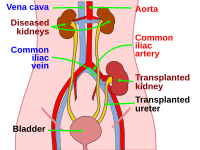
Photo from wikipedia
Background Renin–angiotensin system blockers (RASBs) reduce end-stage kidney disease and cardiovascular event (CVE) development in chronic kidney disease. However, whether RASBs improve long-term prognosis in kidney transplant (KT) recipients remain… Click to show full abstract
Background Renin–angiotensin system blockers (RASBs) reduce end-stage kidney disease and cardiovascular event (CVE) development in chronic kidney disease. However, whether RASBs improve long-term prognosis in kidney transplant (KT) recipients remain unknown. Method We investigated 900 kidney transplant patients in a multicenter retrospective cohort study in Japan and compared death-censored graft survival and CVE (total, cardiac events, stroke) based on RASB use within 12 months after KT. The associations were examined using a Cox hazard model and propensity score-matching analysis. Results The cohort comprised 375 patients treated with RASBs (RASB group) and 525 patients without RASBs (control group). The median observational period was 82 months, with 68 patients reaching graft loss: 79 total CVE, 36 cardiac events, 26 stroke. In a matching cohort comprising 582 patients, death-censored graft survival, total CVE, and cardiac events were not different between the two groups. Only stroke incidence rate was significantly lower in the RASB group compared with the control group (1.4 vs. 6.4 per 1000 patients/year, log-ranked P = 0.005). In a multivariable analysis, stroke events were also significantly lower in the RASB group compared with the control group (Hazard ratio and 95% confidence interval, 0.20 [0.04–0.62]). Conclusion Thus, RASBs potentially reduce stroke events in KT recipients.
Journal Title: Clinical and Experimental Nephrology
Year Published: 2019
Link to full text (if available)
Share on Social Media: Sign Up to like & get
recommendations!